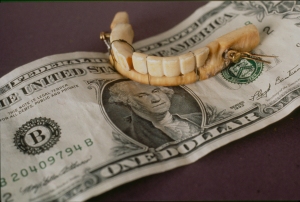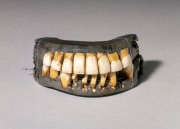I recently visited the Heinz History Center in Pittsburgh, PA where there was an exhibit about George Washington (it will be there through July), and I was inspired by how much modern dentistry could have helped good old George. This is part two of a four-part series about how America’s first President would have benefited from modern dentistry. This time we’ll be delving into how we could have saved George Washington’s teeth instead of taking them out (without anesthesia).
As Stated in our last post, denstists of Washington’s day used a “fire fighting” approach, where if a problem announced itself (usually as pain), it was then taken care of. Modern dentistry has taken on a preventive approach. In this approach we are looking for small problems and fixing them before they announce themselves. Let’s talk about the different options available.
The National Dental Museum in Baltimore has a fantastic Presidential Collection with artifacts from George Washington on display.
With the advanced diagnostic techniques available, today we are able to diagnose decay at its earliest stages now and manage decay effectively with minimal to no pain. If George had visited a modern dentist like those at Chips Dental Associates, he would have had access to DiagnoDent©, where we would have screened the grooves of his back teeth for the earliest signs of decay. When decay is found at this early stage, it can be treated with the smallest restoration possible using modern tooth colored resins. These restorations can actually serve to strengthen the tooth and with regular care and maintenance, may be all that ever needs to be done on it.
George Washington would also have had access to regular periodontal screenings and maintenance. These would have caught any signs of periodontal disease at an early stage and steps could have been taken to minimize its effect on his dentition. By diagnosing this disease at an early stage, most of the time it is possible to treat it non-surgically and keep the patient on a maintenance program where they have cleanings and periodontal screenings at every visit. This step would have helped George Washington to avoid losing any teeth to this disease.
When decay became more advanced, 18th century Americans were occasionally fortunate enough to have a dentist place fillings. While fillings were a part of the 18th century dentist’s repertoire, they were time consuming, expensive, had a relatively low success rate. The technique called for the drilling out or cleaning out of the cavities and placing a material (usually a metal such as gold or even tin) into the space to keep it from becoming sensitive. This was executed without local anesthesia. Unfortunately, not many 18th century dentists placed fillings and when decay reached the pulp, the modern root canal therapy was not an available option. George Washington would probably not have had access to dental fillings as they were a more popular treatment in France during his lifetime.
The modern root canal therapy was developed within the last 100 years and has changed the face of dentistry from a philosophy of extracting teeth and putting in dentures to one of saving and restoring teeth with modern scientifically proven materials. According to John L. Santopolo, an endodontist (root canal specialist) in Long Island, NY, the oldest theories regarding the birth of the root canal therapy date back to the second or third century BC. A skull with a bronze wire inside one of its teeth has been studied and researchers suggest that this may have been used to treat an infected pulp making it the first evidence of such treatment. While George Washington may have had access to this treatment, it was uncommon in the 1700’s and most dentists would not have provided it as an option.
For the sake of our discussion, we’ll assume that even with our modern preventive dental model, George Washington got a toothache during his lifetime. What would have happened? If he had been going to his regular maintenance appointments, it is likely that his tooth could still have been saved. He would have, most likely, wanted to have a root canal therapy, build-up (a type of filling to prepare a tooth for a crown), and crown. By completing this sequence of treatment, he would have saved his tooth and with regular maintenance thereafter (including the occasional replacement of the crown), he would have been able to, most likely, maintain his tooth for the rest of his life. So, going back to our title, if George Washington had known about it, he would have actually wanted not only a root canal therapy, but also a build-up and a crown.
Coming next, local anesthetics, bridges, and dental implants.
Brought to you as a community service by Chips Dental Associates, LLC.
If it’s been a while since your last dental visit or you just want to get together to discuss our favorite historical character, visit www.chipsdentalLLC.com.




